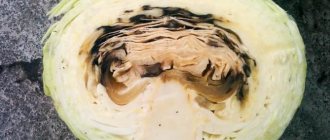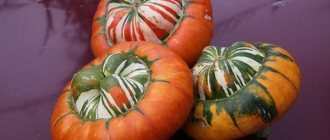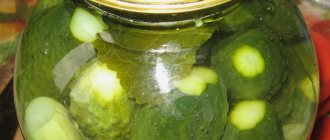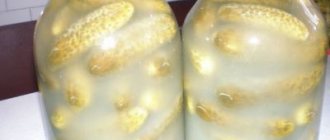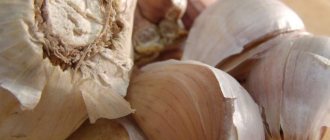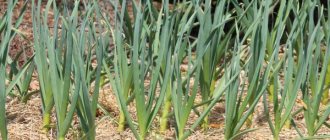White coating on pickles - mold or not
Subject to preservation technology and storage rules, pickled cucumbers should not spoil . If a white coating appears on them, this is normal and should not be a concern. But it is possible that mold has formed on the cucumbers and they have changed their properties - then by eating such a product, you are risking your health. There are a number of signs by which you can determine how hopelessly damaged the workpieces are.
First you need to know exactly what recipe the cucumbers were prepared according to . If without adding vinegar or a similar preservative, without acid, only with salt, then the cloudiness of the brine and the appearance of a white coating is a natural process of formation of lactic acid. Subsequently, the cloudy sediment sinks to the bottom, and the brine becomes more transparent.
In what cases is it botulism?
Botulism is a serious disease that is caused by putrefactive fungi that produce a toxic substance, botulinum toxin, that is fatal to humans. The main danger of this toxin is that its presence in homemade preparations cannot be determined by color, smell or taste.
Bacteria are not destroyed by most conventional disinfection methods ; they can develop in an airless environment, in hermetically sealed jars. They are not killed by adding table vinegar or table salt to canned food. It is very difficult to get rid of botulinum spores at home.
Preventive measures include maintaining cleanliness during preparation.
The only way to protect yourself is heat treatment . When canning, this means thoroughly boiling the jars and lids; after opening the jars, they are heated in boiling water for up to 30 minutes to destroy the toxin.
In what cases is it lactic acid?
The white coating that appears on pickled and canned vegetables is lactic acid bacteria, a fermentation product. The presence of these bacteria indicates that fermentation processes are underway .
Fermented foods are a source of natural probiotics . Lactic acid bacteria help fight the development of pathogenic microflora in the intestines. If the cucumbers have not changed their smell and remain hard to the touch, wash off the white coating and eat the vegetables.
But if the appearance of plaque is accompanied by swelling of the jar , an unpleasant odor when opening and softening of the products, this is an alarming sign.
These cucumbers should not be eaten.
Gourmet cheeses
Probably everyone has heard about cheeses with noble mold, for example, Roquefort, Dor Blue, Gorgonzola and others. It is the mold that gives them their piquant, unique taste. Their use is absolutely safe. However, please note that other, ordinary mold may also appear on them. In this case, you cannot eat cheese. This is especially true for soft varieties, such as Brie or Camembert. If ordinary mold appears on Gorgonzola, then the rule is the same: cut it off with a knife and eat it calmly.
Microplastics on the surface of the Arctic Ocean - synthetic textiles
Bring back Comedy Women: Nadezhda Sysoeva admitted that she misses the show
Alexey Panin is in Russia, the actor posted a touching post about his mother
When can cucumbers be saved?
Before you throw away your pickles, you should first find out if they can be saved.
How to determine the suitability of cucumbers for consumption
Workpieces that retain the following characteristics remain suitable::
- little mold;
- cucumbers are strong, elastic, not soft;
- The smell of brine is natural, not putrid.
In this case, after some actions, you can continue storage.
What to do with these cucumbers
The mold is removed, the vegetables are washed from plaque, placed in a clean, sterilized jar and filled with new brine. After this, put it in a cool place.
If cucumbers are stored in a barrel or other large container (pan, bucket), you can rinse or throw away only those that were in the top layer. Then add fresh brine and add mustard powder.
Trying expired canned food from 1940
In no case! They wrote and showed a lot about mold. So it shouldn’t be confused with penicillin. Opened the jar and in the summer put horseradish leaves on top. If you have it... but if not, I always put mustard plaster under the lid, so it won’t mold in the refrigerator for quite a long time.
In our village, it also happened that there was mold floating in a barrel of cucumbers, but not in the form we were used to, it was a little different. The cucumbers were washed and served. We ate everything, the taste was excellent and it was like a given. The cucumbers didn’t smell bad, and no one had loose stools. Probably, it’s all about the material from which the container is made. If mold appears in a jar at home, then such a jar goes into the garbage chute without regret. And if there are a lot of jars at home, then the cucumbers fly away along with the three-liter jar. We have long heard about the harm of mold; the environment used to be better, but now you can’t eat many foods because of a small speck.
If you fermented the cucumbers in a barrel yourself, then I would probably eat them after washing them. And when visiting, you give up a lot. Some wormy mushrooms are salted and then eaten.
Causes of mold on pickled cucumbers
The main reason for damage to homemade products is violation of preservation technology or failure to maintain cleanliness . All products used must be thoroughly washed, jars and lids sterilized. Any dirt that gets inside can trigger the process of putrefactive fermentation and mold formation.
Violation of the recipe and the use of inappropriate ingredients may also be the cause . Salad cucumbers are not intended for long-term storage and are not suitable for canning; you need to choose special varieties for pickling. Carefully ensure that the vegetables are fresh and without signs of rot.
Attention! It is not recommended to use iodized salt instead of table salt.
The cause of spoilage of the products may be a lack of salt, as well as non-compliance with storage rules .
How to properly pickle and seal cucumbers to prevent mold from appearing on them
There are two ways to pickle cucumbers: hot and cold . In the first case, they are filled with hot brine, rolled up with iron lids, after which the jars are stored at room temperature. In the second, they are filled with cold water, covered with nylon lids and stored in the refrigerator or cellar.
Advice. To prevent white plaque or mold from appearing, when salting, add dry mustard and place horseradish root or raspberry leaves on top.
Before spinning the cucumbers, the jars are sterilized.:
- potassium permanganate solution;
- ferry;
- by boiling;
- in the microwave;
- in an electric oven.
Before sterilization, make sure that the jars and lids are intact : there are no chips on the glass, the iron lids are not deformed. Before the procedure, wash them with laundry soap.
Rules for storing pickles to prevent mold from appearing in the jar
There are several other simple techniques that will significantly improve the preservation of salted products. So, in addition to following the technology for pickling mushrooms, it is recommended to resort to the following tricks, which do not require any special additional costs or a lot of time:
- The preservative properties of brine can be enhanced not only with the help of salt, but also through the use of other spices and spices, which also contribute by naturally having pronounced fungicidal properties. This can be a small amount of 9 percent vinegar, peppercorns, whole cloves of garlic, horseradish leaves scalded with boiling water, mustard seeds and other ingredients.
- To ensure high-quality preservation of products, strictly defined containers should be used. If these are jars, then only glass ones, while for open salting you can use wooden tubs and barrels, as well as enameled basins, bowls and cans. But it’s better to immediately discard clay and plastic dishes and stainless steel containers, as this is not the best option for pickling.
- When storing mushrooms in open containers, you should never use bags, cling film or foil instead of a lid, as such materials only contribute to the development of mold. Instead, it is recommended to give preference to gauze folded in several layers, which must be regularly moistened with a vinegar solution, remembering to replace it with a new one in case of mold formation.
- Mold, which has been formed for no more than 26 hours, can be killed for sure only by boiling the mushrooms twice. In this case, the total processing time should not be less than 15 minutes.
- The free edges of the dishes should be treated with a cotton swab or a clean sponge soaked in a vinegar solution.
- It is recommended to constantly monitor the volume of liquid, which tends to evaporate during the open salting method.
Advice!So, at the slightest exposure of mushrooms, you should immediately make up for the brine deficiency, each time using a freshly prepared mixture.
- When using oppression, which is usually a plate with a load placed on it, you must ensure that no air bubbles form between it and the mushrooms. It should be remembered that only a tight fit of the dishes to the mushrooms, completely immersed in liquid, will help to avoid their appearance.
If black mold appears on the mushrooms, then it is necessary to get rid of them, and urgently. And all because this type of fungal infection is rightfully considered the most dangerous to health, and doctors do not even recommend breathing with them in order to avoid small particles getting into the respiratory system.
Rules for storing pickled cucumbers
Jars with blanks are kept in a cool, dark place. Barrel pickles are stored at a temperature of about 0°C, observing the following conditions :
- the brine completely covers the cucumbers;
- they are under oppression;
- the temperature is constant, without sudden changes.
Sometimes pickles are stored frozen . To do this, they are removed from the brine, excess moisture is removed, portioned into containers or bags and placed in the freezer. Afterwards it is better to subject them to heat treatment - add them to hodgepodge, rassolnik or pizza.
Barrel pickles can be stored in containers after washing them, drying them and sprinkling each layer with mustard powder.
Causes
White coating on pickled cucumbers occurs for the following reasons:
- natural fermentation process;
- damage by putrefactive bacteria, yeast due to improper preparation of the product or storage.
In the bank
Irregularities in preparation lead to molding of cucumbers in a jar:
- improper sterilization of glass containers and lids;
- lack of brine, in which it does not completely cover the cucumbers;
- poorly washed vegetables;
- unsuitable ingredients or incorrect recipe;
- air entering the can;
- use of varieties grown only for fresh consumption.
Another reason is non-compliance with the storage conditions of the workpieces.
In a barrel
On barrel pickled cucumbers, plaque forms due to:
- non-compliance with the recipe;
- insufficient amount of brine;
- storage without oppression or in unsuitable conditions;
- sharp temperature fluctuations.
Is it possible to eat pickles if they have mold on them?
Mold looks like spots or islands on the surface of the brine and can cover the entire space under the lid of the jar with a cap. It appears as a result of ingestion of contamination or infection.
If at the same time the jar swells, the cucumbers become soft, slippery, and smell bad - throw them away without hesitation: they can seriously poison you. Moldy foods should not be eaten.
Reasons for cloudiness of cucumbers in jars
There may be several explanations for such strange behavior of salted or pickled vegetables, and each one is fraught with a separate reason. It happens that the solution, along with the cucumbers, simply turns white and nothing else happens. It is believed that nothing happens by itself, which means we need to look for the root causes of such strange phenomena.
They are most often the following:
- The cucumbers were not washed well enough; small particles of debris and soil remained on them, which, being in a confined space, led to fermentation. This also includes contamination that gets in with spices for preservation.
- The problem is with the jars: they were dirty or synthetic products were used to wash them (usually it is recommended to use chemically neutral and harmless baking soda).
- Instead of ordinary table salt, sea or iodized salt was used - they contain components that cause gradual clouding of the brine.
- Poor sterilization of jars and lids, not only empty ones, but also at the final stage, when processing is performed before sealing.
- Low-quality lids, chips or cracks in the neck - all this leads to air getting inside and inevitable fermentation.
Soft cheeses and cheese slices
Cottage cheese, cream cheese, Neufchatel, Belle Paese, goat cheese - these varieties should be thrown away immediately if you find mold on them. They also contain a lot of moisture, so they easily become moldy both on the surface and in the depths, which means they become a breeding ground for bacteria. The same goes for sliced cheeses: they often become contaminated by the tool used to cut them.
Disposable helmet for dental patient will protect doctor from COVID
For which abdominal pain should you urgently see a doctor: Dr. Komarovsky explained
Do-it-yourself wooden watch with a leather strap: making spectacular decor
Are cucumbers with cloudy brine edible?
It is impossible to answer this question unequivocally, since there is always, albeit tiny, the possibility that botulism bacilli accidentally got into a jar of pickled or pickled cucumbers, lovingly prepared for long-term storage.
At a minimum, those who consume the “playing” product are at risk of indigestion, or even serious poisoning. Therefore, a simple method of recognizing the severity of the problem is usually used, so that you can then decide whether the game is worth the candle.
Example 1. When catastrophic changes in the color of the brine or marinade are detected within 2-3 days after seaming, sometimes it is advisable to try to correct the situation. As practice shows, the solution becomes cloudy if lactic acid fermentation occurs in it (which in itself is not so scary), but the process cannot be stabilized due to the lack (complete absence) of an important component - vinegar.
If, moreover, the lid is not swollen, then we can safely recommend a simple solution: open the jar and pour the brine out of it.
Then there are 2 ways - use the “old” brine or prepare fresh one. In any case, without removing them from the container, rinse the cucumbers with boiling water, leave for 5 minutes, then proceed to the solution. The new (remaining) brine is brought to a boil, the vegetables are poured into the jar, vinegar is added according to the dosage, after which it is sterilized and rolled up.
Example 2. If the solution becomes cloudy without deformation of the lid, such cucumbers, in most cases, are quite edible. You just have to transfer the jars with them to the refrigerator and observe for 7-10 days. Most often, after the specified time, all the sediment will be at the bottom, and the contents will again become transparent. Sometimes such “incorrectly pickled” cucumbers are successfully used for pickle or vinaigrette, where their taste will not harm other ingredients.
Example 3. Both signs of fermentation are present - cloudy brine and a swollen lid. In this case, eating cucumbers is strictly not recommended, since there is a high risk of pathogenic bacteria entering the brine. You can, of course, take a risk, but the result will be unpredictable. And the human life of the owner and her loved ones is at stake.
What to do if home-picked milk mushrooms become covered with a white coating?
For several years now in the fall, my relatives have treated me to a jar of salted milk mushrooms. These are white milk mushrooms, salted in the usual cold way in a tub and transferred especially for me into a glass jar.
Since I am not a particular fan of milk mushrooms, I don’t eat them right away, and this jar continues to be stored in the refrigerator for some time.
But over time, a white coating begins to form on the surface of the mushrooms, and even the brine itself in the upper part of the jar becomes whitish-cloudy.
If anyone knows, tell me what it is? Mold? Or discharge from the garlic used in salting? And can such mushrooms be eaten?
Red Guards
Yes, the white coating in salted mushrooms is mold, but you shouldn’t throw away such mushrooms, you just need to rinse them in running water and you can safely eat them or (if there are a lot of mushrooms) replace the brine in them.
Zolotynka
The white coating is not mold; the exact same coating sometimes covers pickled cucumbers. It is formed due to garlic, which was most likely added to the jar in large quantities. This plaque is not dangerous, you just need to wash it off with cold water and you can eat it safely.
As for mold (it looks different and cannot be confused with plaque), if there is any suspicion of its presence, it is best not to eat such mushrooms, as well as any other food. It is clear that salted milk mushrooms are still a delicacy, but believe me, health is more valuable than a few minutes of pleasure. Mold, unfortunately, cannot be washed off with water and cannot be eaten. Except, of course, specially grown, for example, in expensive cheeses.
Tju
Oh, how I envy you) There have been no salted milk mushrooms on our table for several years now. I can give you some advice - to prevent this embarrassing film from forming, place a leaf of horseradish on top, and then change it after a while. If there is no horseradish leaf, you can sprinkle mustard (ordinary powder) on top, and then simply remove the top mushroom along with the mustard. Once upon a time, our neighbor poured vodka over mushrooms in a jar and said that it helped with long-term storage. They also put a clean cloth on top, then throw it away. Sometimes the brine is drained and refilled with new brine.
And before eating, just rinse the mushrooms with water if mucus has formed. After all, the jar contains organic matter). They can also be used after heat treatment, for example, in a pie with potatoes or sauerkraut and milk mushrooms.
Andrey0817
In any pickles, be it cucumbers, tomatoes or mushrooms, a thin film of white mold appears if air gets in there.
This film is not dangerous and it does not mean that the mushrooms are gone, they remain very edible.
In our tub with salted mushrooms, such a film appears over time (somewhere in the middle of winter).
We take out the mushrooms, wash them with cold water (if the milk mushrooms are very salty, then soak them for several hours), cut them, season with fresh chopped onions and butter.
And that's it, you can eat.
ALeSkA
this is mold, and mold cannot be washed out even with boiling water, it is better not to take risks, this way you can get food poisoning (at best), scientists have proven that mold is difficult to remove from the body and it contributes to the development of abdominal cancer. Especially mushrooms, this is dangerous thing, they are very easy to poison, throw them away, washing will not get rid of the “poisons” that mold has formed.
How to revive cloudy preserves
There is no universal solution to the problem; sometimes it is easier to prepare something anew than to fix it. Simply put, throw away spoiled products and then carefully follow the technology. To begin with, time is important: the sooner signs of fermentation are detected, the better. Then they notice whether the shape of the lids has changed (whether swelling has appeared).
If not, then the chances of success increase: you can try to pour out the solution, rinse or sterilize the cucumbers, and then fill them with fresh solution. Most often this works: pour boiling water over the vegetables directly in the jar, let them sit for a few minutes, pour out the liquid, then fill the container with freshly prepared solution.
Be sure to add vinegar, after which it is preserved as usual: sterilization, seaming, keeping it upside down for 24 hours. This is how you can redo unsuccessful salting.
You should be prepared for the fact that the taste of such cucumbers will be slightly different from the classic one, so experienced housewives use “spoiled” jars for preparing soups or stewing vegetables.
Manipulations with fermented cucumbers should be undertaken if there are no signs of rapid development of bacteria (blowing of the lid). In any case, there is a small chance of food poisoning from consuming improperly processed canned goods.
Why does mold appear and why is it dangerous?
Having decided on the advisability of eating moldy mushrooms, it makes sense to consider the reasons for its occurrence, because the knowledge gained will help to avoid such unpleasant consequences in the future. Thus, among the main reasons that provoke the development of mold in pickles are:
- Incorrect or short-term preparation of containers for pickling. This includes the absence or insufficient time of sterilization, dirt in the jars or the presence of foreign components in them that can get inside completely by accident.
- Violation of storage rules, most often due to incorrect temperature conditions and high levels of humidity in the room, which contribute to the development of pathogenic microorganisms, including mold spores.
- Deficiency of preservatives, which is used in this case as table salt. Thus, the slightest change in the recipe for preparing mushrooms for future use can lead to them starting to disappear, so there is no need to skimp on salt, because in extreme cases, the mushrooms can be washed, thus getting rid of its excess.
- Voids in containers.
Important!You cannot fill the jars halfway or ¾ full, as the remaining air gap can easily provoke fermentation. The same can be said about the liquid, which should completely cover the mushrooms. If there is a shortage of it, you can use refined vegetable oil, which is also suitable for filling the volume.
- Unsanitary conditions. If we are talking about storing products under pressure, for which wooden or enamel dishes are usually used, then it is necessary to monitor its cleanliness by regularly wiping its sides and constantly changing the top gauze layer along with the mold that forms on it.
Ways to prevent the appearance of “suspicious” sediment
There are not many of them, but they exist. Firstly, it is a thorough processing of vegetables before preservation: removing tails, damaged areas, cleaning from dirt (many experienced housewives soak cucumbers for several hours before pickling, then rinse thoroughly again).
Secondly, these are clean jars washed with soda without traces of food, debris, detergents, as well as new (not reused!) sealing lids without damage, deformation, with rubber bands in good condition. This category also includes the absence of visible and tangible damage to the neck of the glass container, cracks, chips, and casting defects.
Add a comment Cancel reply
You must be logged in to post a comment.
White coating is not always an indicator of mold, but may be the result of fermentation. Determining whether it is mold or lactic acid is very simple. If you pickle vegetables without vinegar, and use only salt and water, then the white coating is nothing more than acid and after washing it off , you can enjoy delicious crispy cucumbers. However, let us dwell on the situation when mold occurs on canned cucumbers.
Why does a white coating form on pickled cucumbers and is it dangerous?
The reason for the formation of mold can be: lack of tightness, poorly sterilized containers and lids, and failure to comply with the proportions in the recipe. And even “wrong” cucumbers.
Of course, moldy, sour cucumbers cannot be eaten! Their taste and smell are unpleasant, they become soft and unsuitable for consumption. The appearance of mold and cloudy brine means that bacteria have entered the workpiece and have begun to multiply. Such cucumbers must be thrown away; you should not risk your health.
Salami and cured country hams
The fluffy white growths on some sausages, such as salami, are so-called noble mold. It essentially protects the sausage from the penetration of harmful bacteria. The same applies to dried hams: the formation of mold on their surface is a completely normal and harmless phenomenon. You can simply scrape it off, and the product is ready for use again.
Delicate, beautiful and incredibly tasty dessert made of chocolate and butter cream
Delicate creamy cake with cookies and 4 oranges: recipe
A non-standard take on pizza: with sauce and shrimp on the edges
How to save pickled cucumbers if a white coating appears on them
Pickles do not last long in an open jar.
If the brine has become cloudy and no more than 2-3 days have passed, then you can still save the situation:
- Drain the cloudy brine and rinse the cucumbers with boiled water.
- The lid and jar need to be sterilized again.
- Make the brine (the same as you did if the recipe is correct).
- Add spices and seasonings, as the ones used have already given off their taste and aroma.
- Pour brine over the vegetables and roll up.
How to properly sterilize jars and lids before screwing
Improper sterilization leads to spoiled workpieces.
All components and ingredients must be clean so that microorganisms do not get into the preparation for the winter:
- Check jars and lids for chips and scratches.
- Prepare all ingredients thoroughly.
- Sterilization time depends on the size of the container: 1–2 liter jars are exposed to steam for 10–15 minutes. A three-liter bottle takes 20–25 minutes.
- Allow sterilized jars and lids to dry.
How to properly sterilize lids and jars
When pickling cucumbers, it is important to pay attention to proper preparation. The sterilization process is considered particularly important. The procedure is simple:
- First of all, jars and lids need to be checked for integrity. Containers with chips are not used, as are lids with deformation.
- It is important to wash all containers well with baking soda or laundry soap.
- For steam sterilization, you will need a pan of boiling water; a special sterilization grid is placed on it.
- The cans are carefully placed in the structure upside down and the neck down. Gradually large drops of moisture appear on the walls, the sterilization process is completed.
- The lids are simply placed in boiling water and left for a few minutes.
After the jar is completely dry, you can put cucumbers in it. This is done on the same day, the container remains sterilized for about 4 hours.
It is important to properly sterilize jars
Further sterilization is carried out as follows:
- The jars with the product are carefully placed in a large container; cold water should cover it almost completely.
- Gradual heating is carried out so that the container does not burst due to sudden temperature changes.
- After the water boils, leave the jars in the water for another 5 minutes. Then you can take them out - the product is ready.
Sterilization can also be carried out in the oven. This method is convenient because you can process several containers at once:
- Place several jars on a baking sheet, neck down.
- Set the temperature to 120 degrees.
- The duration of the process is 12 minutes.
The procedure can be carried out in a microwave oven. A small amount of water is poured into the container - about 2 cm. The power for sterilization is 850 kW. The processing process lasts up to 3 minutes.
Attention! The simplest option is to treat the containers with a weak solution of potassium permanganate. However, complete sterilization cannot be guaranteed with this method.
Features of storing pickled cucumbers
After you have made the twists and checked for leaks, turn them over and place them on the lid for a more complete fit. To increase the heat treatment time, the preservation is wrapped and left to cool gradually. After a day or two, the workpieces should be placed in a cool, dark place. The ideal option is a cellar.
There are several effective folk methods for extending the “life” of conservation, guaranteeing the absence of mold.
They say that mold will not appear if you add:
- Mustard powder. Place mustard plaster under the lid (you can place mustard powder in a piece of fabric) and close.
- Black peppercorns. Place the pepper in the bag in the brine.
- Adding a teaspoon of mustard powder or peppercorns directly to the brine will also extend the shelf life.
- The optimal temperature for storage is from –1°С to +1°С. The higher the temperature, the faster bacteria develop and the cucumbers become unusable.
Video: To prevent pickles from molding
To summarize, we can summarize - to prevent your cucumbers from becoming moldy, you need to follow the canning rules and shelf life. White plaque is formed as a result of the activity of microorganisms.
- Author: Maria Sukhorukikh
Rate this article:
- 5
- 4
- 3
- 2
- 1
(0 votes, average: 0 out of 5)
Share with your friends!
